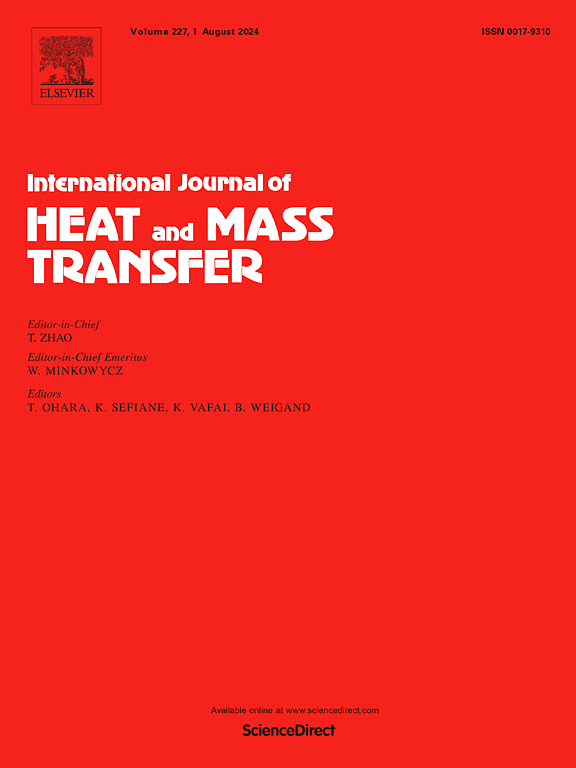A bulk nucleation model for flashing applications
IF 5
2区 工程技术
Q1 ENGINEERING, MECHANICAL
International Journal of Heat and Mass Transfer
Pub Date : 2024-10-29
DOI:10.1016/j.ijheatmasstransfer.2024.126244
引用次数: 0
Abstract
Modeling flash evaporation cases is challenging due to their occurrence in high temperatures and mass flow rates, along with mass transfer taking place in a narrow region of space. As an improvement to the previous Limited Evaporation model, which was based on the normalized critical work of nucleation, a new Bulk Nucleation model based on Classical Nucleation theory is developed and tested in comparison with liquid–vapor evaporation experiments conducted at the Brookhaven National Laboratories. The original theory is modified to take into account the cluster size formed during nucleation and a minimum threshold of vapor volume fraction required to trigger large-scale mass transfer. The Bulk Nucleation model shows better predictions for radial volume fractions, representing an improvement over well-correlated predictions for area-averaged pressure and volume fractions. The discrepancy in the radial volume fractions is attributed to the presence of pressure taps used in experiments, which protrude into the fluid domain. The role of model parameters such as cluster size and vapor volume fractions in the mass transfer model is also discussed in detail in this study. Similar to previous work, the new model is implemented in the open-source Computational Fluid Dynamics solver OpenFOAM in an Euler–Euler framework, which provides for the use of inter-momentum forces such as lift, drag, and turbulent dispersion, which are essential for accurate predictions for transport and generation of new vapor bubbles.
闪光应用中的体核模型
由于闪蒸发生在高温和高流速条件下,并且在狭窄的空间区域内进行传质,因此闪蒸模型的建立极具挑战性。之前的有限蒸发模型基于成核的归一化临界功,作为对该模型的改进,我们根据经典成核理论开发了新的块状成核模型,并与布鲁克海文国家实验室进行的液气蒸发实验进行了对比测试。对原始理论进行了修改,将成核过程中形成的团块大小和引发大规模质量转移所需的蒸汽体积分数最低阈值考虑在内。成核模型对径向体积分数的预测更准确,比对区域平均压力和体积分数的相关预测有所改进。径向体积分数的差异归因于实验中使用的压力抽头的存在,它突出到流体域中。本研究还详细讨论了模型参数(如团簇大小和蒸汽体积分数)在传质模型中的作用。与之前的工作类似,新模型是在开源计算流体力学求解器 OpenFOAM 中以欧拉-欧拉框架实现的,该框架提供了对升力、阻力和湍流扩散等动量间作用力的使用,这些作用力对于准确预测新气泡的传输和生成至关重要。
本文章由计算机程序翻译,如有差异,请以英文原文为准。
求助全文
约1分钟内获得全文
求助全文
来源期刊
CiteScore
10.30
自引率
13.50%
发文量
1319
审稿时长
41 days
期刊介绍:
International Journal of Heat and Mass Transfer is the vehicle for the exchange of basic ideas in heat and mass transfer between research workers and engineers throughout the world. It focuses on both analytical and experimental research, with an emphasis on contributions which increase the basic understanding of transfer processes and their application to engineering problems.
Topics include:
-New methods of measuring and/or correlating transport-property data
-Energy engineering
-Environmental applications of heat and/or mass transfer

 求助内容:
求助内容: 应助结果提醒方式:
应助结果提醒方式:


